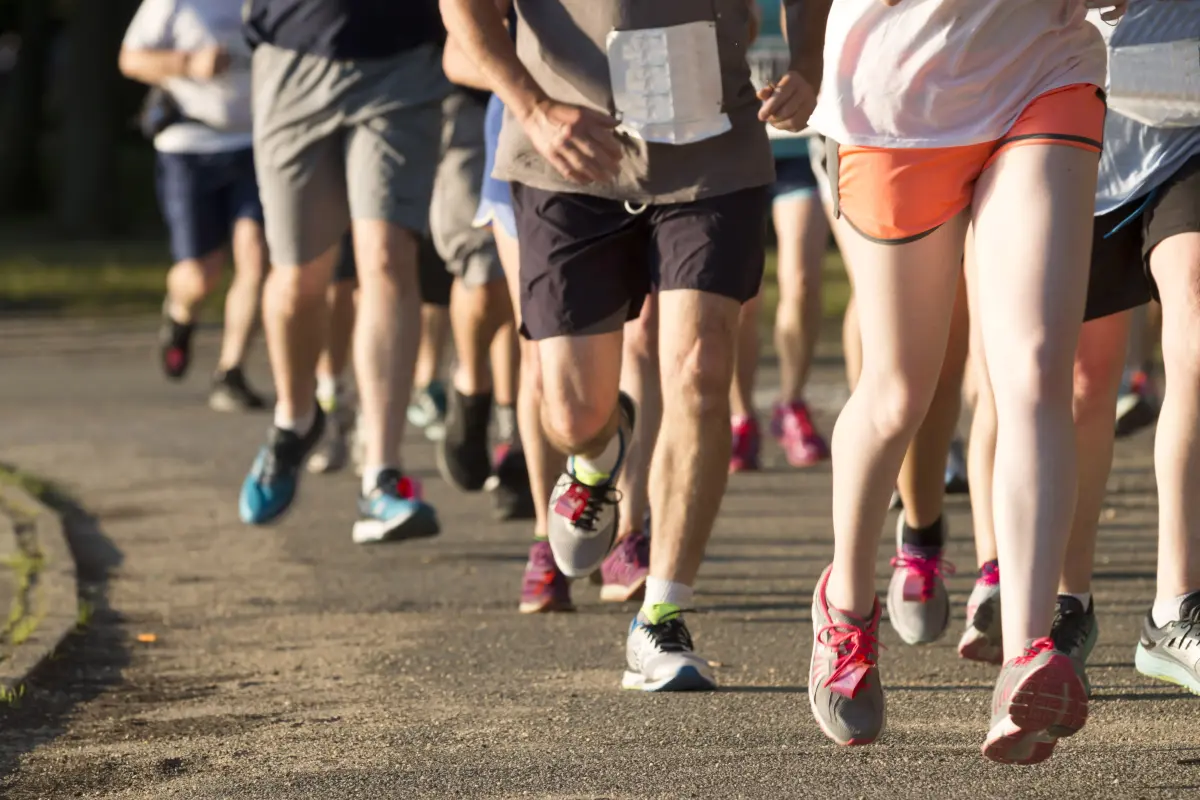Essential Running Form Techniques for Enhanced Performance and Injury Prevention

Welcome, fellow runners, to a world where form meets function, each stride counts, and where the difference between a leisurely jog and a performance-enhancing run lies in the subtle details of technique. Picture the wind in your hair, the rhythm of your feet hitting the ground, the rush of adrenaline - it all starts with mastering the art of running form. Ready to explore?
Key Takeaways
- Proper running form, involving posture, stride, and foot strike, is essential for efficiency, energy conservation, and injury prevention and requires practice and professional guidance.
- Arm movement synchronization with leg motion, maintaining a 90-degree elbow angle, relaxed shoulders, and fluid arm swings are crucial for running efficiency.
- Incorporating diaphragmatic and rhythmic breathing techniques, maintaining a cadence of around 180 steps per minute, and performing strength and flexibility exercises improve running performance and form.
Mastering the Fundamentals of Running Form
Running may seem simple at first glance; it's as natural as breathing. But the form - the posture, stride, and foot strike separates an efficient run from an energy-draining jog. Mastering these fundamentals can give you the edge, helping you:
- run faster
- conserve energy
- prevent injuries
- improve your overall running performance.
Start by maintaining proper running form, essential for achieving correct running form and a good running technique. Ensuring adequate form, in general, will help you avoid injuries, improve your overall performance, and develop a proper running technique.
Posture Perfection
Ever watched elite runners glide through the track, their bodies leaning forward, their gaze steadfast? That's the quintessence of running posture – a tall, slight forward lean, with ears over shoulders, looking ahead about 15 to 20 feet. A forward lean, initiated from the ankles, helps maintain this posture, giving you the boost to run efficiently and quickly swing forward.
Yet, it's not always simple to maintain this posture. Falling into a forward-head posture or a rounded upper back is common, especially when fatigue sets in. These postural deviations can strain your neck, back, and shoulder muscles, leading to inefficiencies and potential injuries. Perfecting your posture is an ongoing process, requiring conscious effort and, often, a little help from a physical therapist.
Stride Optimization
Another integral element of proper running form is stride length. Visualize running as a pendulum swing. The further your foot lands in front of your body, the greater the braking effect, much like a pendulum swinging too far from its resting position. This is called overstriding and can lead to inefficient energy usage and increased stress on your knees, hips, and lower back.
Adjusting stride length, however, can feel unnatural at first. It's like changing how you walk – it requires patience, practice, and possibly some professional guidance. Gait analysis can be helpful in this process, providing valuable insights into your unique running pattern and helping you find the optimal stride length.
Foot Strike Focus
Foot strike refers to which part of your foot hits the ground first. It may seem trivial, but a slight change in foot strike can significantly impact running efficiency. The optimal foot landing technique is to land with your feet as close to under your hips as possible, regardless of whether it's on your forefoot, midfoot, or heel. This technique can prevent overstriding and improve running efficiency.
Nevertheless, numerous runners succumb to excessive heel strikes, resulting in overstriding and a heavier gait. On the other hand, landing toes first can also counter your forward momentum. So, finding the right foot strike is all about balance and can be a game-changer in your running journey.

The Art of Arm Swing
Let's talk about the unsung heroes of running – your arms. Believe it or not, the swing of your arms can significantly impact your leg movement and overall running efficiency. Swinging the right arm generates an impulse that helps to propel the legs forward with greater ease and rhythm. This motion can enhance the overall fluidity of movement.
Hence, synchronizing your arm and leg movements is vital for mastering running form.
Synchronized Movement
The synchronization of arm and leg movement is a subtle but essential aspect of proper running form. Think of your arms as the pacemakers for your legs - the faster your arms move, the faster your legs will follow. The key is maintaining a 90-degree elbow angle and swinging your arms comfortably beside your body, avoiding excessive arm swing.
But what about the hands? As you swing your arms, your hands should be in unclenched fists, as though gently holding a chip between your thumb and forefinger without breaking it. This technique helps maintain a relaxed upper body, crucial for efficient running.
Relaxed Shoulders
When discussing the upper body, the shoulders must be noticed. Maintaining relaxed shoulders while running contributes to a more effortless and efficient running form, preventing tension buildup during challenging intervals. A relaxed upper body allows for a smoother energy transfer, leading to less fatigue and better performance.
However, it's easy for tension to creep into the shoulders, especially as fatigue sets in. Excessive shoulder tension can lead to muscle tightness, pain, and poor posture, hampering running efficiency. So, remember to keep those shoulders relaxed and square throughout your run – a slight adjustment that can make a big difference.

Breathing Techniques for Better Running
Breathing, like the rhythm of stride and arm swing, significantly contributes to your running form. Efficient breathing techniques can be game-changers in your running performance, helping fuel your body with oxygen without causing hyperventilation.
We shall now examine diaphragmatic and rhythmic breathing and their role in enhancing the running experience.
Diaphragmatic Breathing
Diaphragmatic breathing, often called 'belly breathing,' involves taking longer, slower, and deeper breaths, engaging the diaphragm rather than the chest muscles. This technique enhances:
- Oxygen intake
- Stabilization of core muscles
- Pacing
- Posture
- Reducing tension during recovery
Practicing diaphragmatic breathing might require some conscious effort initially, primarily if you're used to shallow, chest-based breathing. But with patience and persistence, you can train your body to adopt this more efficient breathing pattern, even during the physical exertion of running. The aim is to inhale through the nose for four seconds, then exhale through the mouth for a similar count, creating a rhythm that helps balance the impact stress of running.
Rhythmic Breathing
Rhythmic breathing extends the idea of efficient breathing. It involves coordinating your breathing pattern with your running stride to maintain a steady oxygen supply and minimize physical strain. A typical pattern runners use is inhaling for three-foot strikes and exhaling for two-foot strikes, known as a 3:2 pattern.
The beauty of rhythmic breathing lies in its adaptability. As you progress in your running journey, you may find other inhale-to-exhale ratios that work better for you. The key is to experiment and find a comfortable and sustainable rhythm, helping you optimize your oxygen intake, reduce physical stress, and improve your overall running performance.

Cadence and Efficiency
Another crucial element in achieving optimal running form is cadence, the frequency of your steps per minute. It's the tempo of your run, the beat to which your body moves.
A runner's recommended cadence is around 180 steps per minute, which helps reduce overstriding and improve running efficiency.
Cadence Drills
To help you maintain this optimal cadence, you can incorporate cadence drills into your training routine. These drills, like the 'fast feet' drill and 'cadence counts,' help increase your foot turnover rate, improving your cadence.
Remember, working on your cadence is not just about moving your feet faster. It's about controlling your stride length, maintaining balance, and preventing overstriding. Focusing on cadence can enhance your running efficiency and make each step count.
Strengthening and Flexibility Exercises for Proper Running Form
Strength and flexibility exercises significantly contribute to enhanced running performance alongside running form and breathing techniques. Specific workouts can help you maintain good posture, improve your stride, and prevent injuries.
We will now examine the specifics of exercises for core stability and hip mobility.
Core Stability
Core stability forms the foundation of a good running form. A strong core supports your spine, maintains your posture, and enables efficient movement. Exercises like planks and balance tests can enhance your core stability, providing a solid base for every stride.
But remember, core stability is not just about having a six-pack. It's about engaging your deep core muscles, which include:
- Diaphragm
- Pelvic floor muscles
- Transversus abdominis
- Multifidus
Working on these muscles can enhance your balance, stability, and overall running form.
Hip Mobility
Hip mobility is another crucial aspect of proper running form. Flexible hips allow for a more excellent range of motion, which can improve your stride and running efficiency. Exercises like high knees and resistance-band workouts can help increase hip mobility, preventing hip adduction-related injuries.
Improving hip mobility is not just about stretching before and after your run. It involves strengthening the hip flexors and glutes, maintaining good posture, and incorporating specific exercises into your routine. Remember, flexibility and strength go hand in hand in promoting better running form.
Individuality in Running Form
Now, we should acknowledge the uniqueness inherent in each runner's form. No two runners have the same pace or endurance level, but no two running forms are identical. Each runner's form is shaped by their:
- unique body structure
- flexibility
- strength
- mindset
Determining the form that best suits you necessitates understanding your body, conducting a gait analysis, and demonstrating patience and persistence.
Gait Analysis
Gait analysis is a scientific method to assess a runner's biomechanics and running form. By examining factors like foot strike, stride length, and pronation, gait analysis provides personalized insights into your running technique, helping you identify areas for improvement and optimize your performance.
The advantage of gait analysis lies in its non-generic approach. It acknowledges individuality in running form and offers personalized recommendations. So, whether you're a beginner runner or an experienced marathoner, a professional gait analysis can provide valuable insights into your unique running style.
Patience and Persistence
Determining the proper running form is a continuous process. It requires patience, persistence, and a non-judgmental approach. It's important to remember that changes in running form can feel uncomfortable at first, and noticeable improvements may take time to appear. Don't be disheartened - persistence is key.
Remember, there's no 'perfect' running form. The best running form is the one that allows you to run efficiently, comfortably, and injury-free. So, take your time, trust the process, and keep exploring. Your perfect running form is out there, waiting to be discovered.
Summary
We've explored the world of running form, covering everything from posture and stride to breathing techniques and strength exercises. We've learned that running form is more than just putting one foot in front of the other. It's a delicate interplay of various elements - the lean of your body, the swing of your arms, the rhythm of your breath.
But the beauty of running form lies in its individuality. Each runner's form is unique, shaped by their body structure, strength, flexibility, and mindset. So, as you embark on your journey to improve your running form, remember to be patient, stay persistent, and, most importantly, enjoy the run. Because at the end of the day, it's not just about running faster or farther - it's about finding joy in every stride.
Frequently Asked Questions
How should your feet hit the ground when running?
When running, most runners naturally use a heel striking technique, where the heel hits the ground first, followed by the midsole and toes, stretching and strengthening the calf muscles and ankles.
Should I lift my knees when running?
Yes, lifting your knees when running can increase your range of motion, leading to faster and more efficient movement. It can also reduce the risk of injury.
How do I stop stomping when running?
Focus on maintaining the proper running technique and ensure that your knees land beneath your hips to reduce the force of contact and prevent jolting on your knees when running.
How do I correct my running form?
To correct your running form, imagine yourself as a puppet on a string, keep your hands at waist level, maintain an erect spine, relax your arms, and take small steps. These tips will help you improve your running form and prevent injury.
What is the importance of proper running form?
Proper running form is crucial as it enhances performance, conserves energy, and prevents injuries by maintaining good posture, optimizing stride, focusing on foot strikes, and synchronizing arm swing.